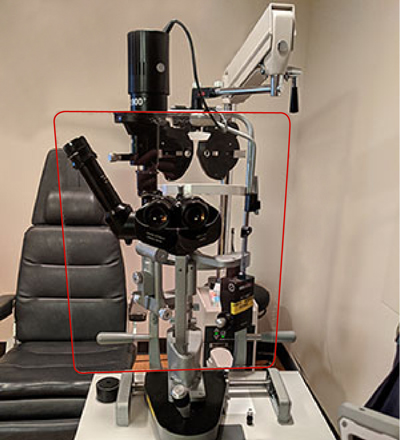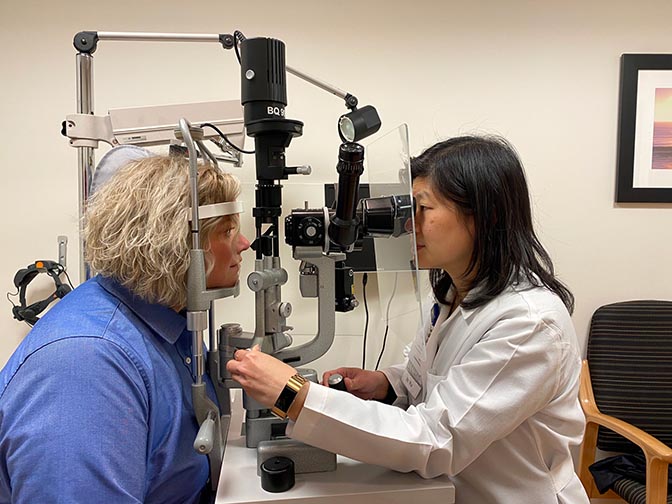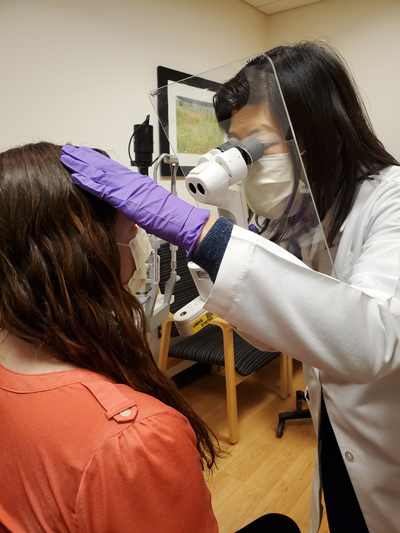
For necessary eye exams, a new breath shield protects patients and doctors
Close proximity eye exams will need to continue during lockdown, calling for increased safety.

Close proximity eye exams will need to continue during lockdown, calling for increased safety.
Despite COVID-19-related lockdowns, face-to-face eye examinations continue to be a necessity for many—a situation that has forced doctors and engineers at the University of Michigan to get creative.

Together they’ve developed an expanded breath shield that can provide greater protection to both patients and doctors during eye exams. U-M engineers moved quickly to design an acrylic plexiglass panel that would fit and work with slit lamp biomicroscopes, a staple of eye examinations. They’ve been installed at the Kellogg Eye Center, where Michigan Medicine is providing urgent eye care to all patients.
If you’ve been for an eye exam, you can imagine the problem. The equipment requires patients to place their chins into a tray, and press their foreheads against a stabilizing piece so their doctor can look closely at the structures of the eye. It also requires the person administering the exam to get up close and personal—within two feet of the patient’s face.
Slit lamp biomicroscopes currently on the market feature breath shields that are, at most, eight inches on any side. At the request of doctors at the Kellogg Eye Center, a U-M team led by Lauro Ojeda, an associate research scientist in mechanical engineering, designed and prototyped a larger shield that is 12 inches by 15 inches.
Before U-M moved to limit campus operations, Ojeda and his team were able to work with a local company to produce 200 shields. Those have been dispersed throughout facilities in the Michigan Medicine system.
Lockdown conditions have relegated many medical visits and procedures to non-essential, but for ophthalmologists, there remain plenty of patients who still need to be seen, said Paul Lee, the Bruce Fralick Professor and Chair of Ophthalmology and Visual Sciences at the Kellogg Eye Center.
“We have patients who still need injections to prevent blindness in cases of macular degeneration,” Lee said. “Others are dealing with retinal detachments and still others have uncontrolled glaucoma. And then there are people who experience sudden vision loss and need to be seen immediately.”

Lee said the initial responses from doctors using the new shield shows it’s working well, and called the project “a wonderful collaboration with engineering to quickly meet a need of high importance to our patients and our health care teams.”
To design the expanded shield, Ojeda started out by replicating what was already on the market.
“We brought it to the hospital and said how should we modify this?”
Lee and his doctors wanted the shield expanded in every direction. So, Ojeda’s team utilized machine shops that were still open on North Campus to remake another shield with expanded dimensions. Once engineers had the specs they wanted, they searched online for companies that could manufacture the pieces.
It provided a lesson in the benefits of buying local.
“There are many sites online where you can simply upload your model and they will give you a quote immediately,” Ojeda said. “Others will respond within an hour or so. For an order of 200, some of the quotes were as high as $23,000, and the lower range was $6,000 to $10,000.
“The next day we started getting feedback from the local shops. On average their quotes were around $1,200 and they were able to turn the orders around much more quickly. So we’ve been working with them since.”
Lee was responsible for kicking the project into gear early in March after watching events unfold overseas.

“The data out of China indicated that opthamologists and ENT doctors were at the greatest risk of contracting coronavirus before the country really knew about it,” he said. “The cumulative exposure and the numbers of patients we are exposed to are quite high. We sit face-to-face with patients and breathe, without the breath shields, the same air.”
Lee is quick to point out other research institutions have done similar work in recent weeks—a sign of how great the need is for improved protections. Ojeda and his team are making the design specs for their shields available to the public.
And they are currently designing shields for portable slit lamp biomicroscpes, devices that require even closer proximity for doctor and patient. The work is somewhat slower without access to U-M’s workshops, but it continues by hand where team engineers can find the equipment.
Lee said he believes the shields will be of benefit long after COVID-19 has run its course.
“It helps us deal with the normal occurrence of people with colds, flus or things like that,” Lee said. “Everything that we can do to help reduce the transmission of various respiratory infections would be very useful.”